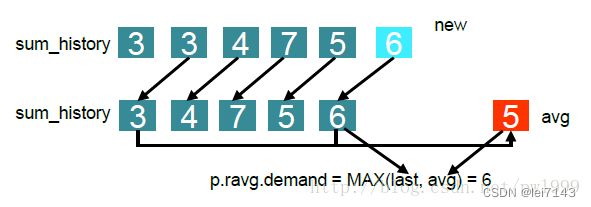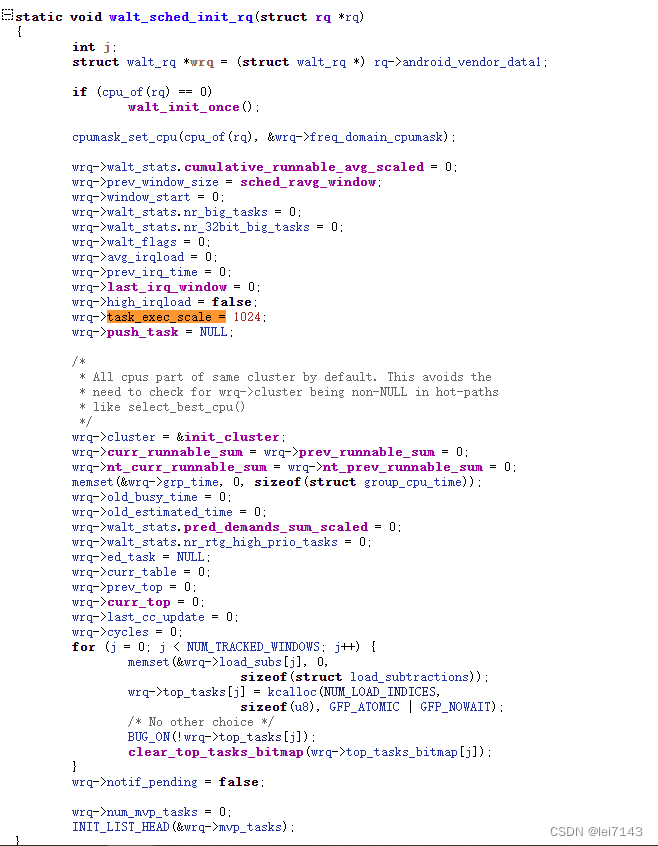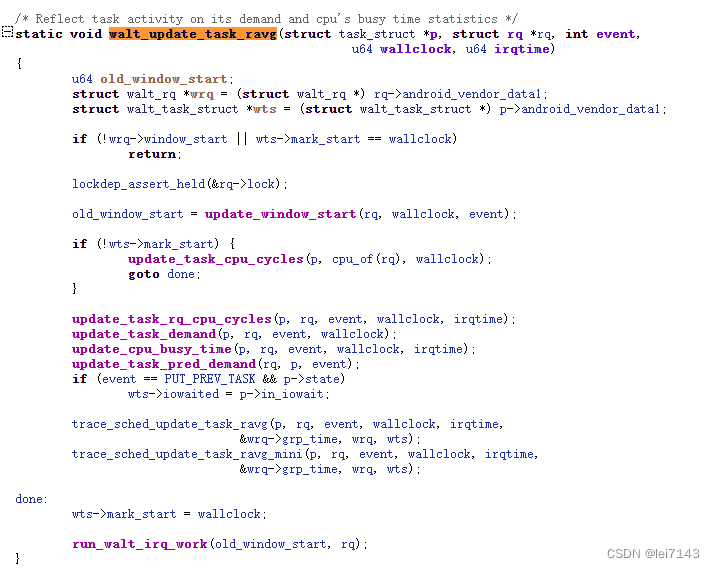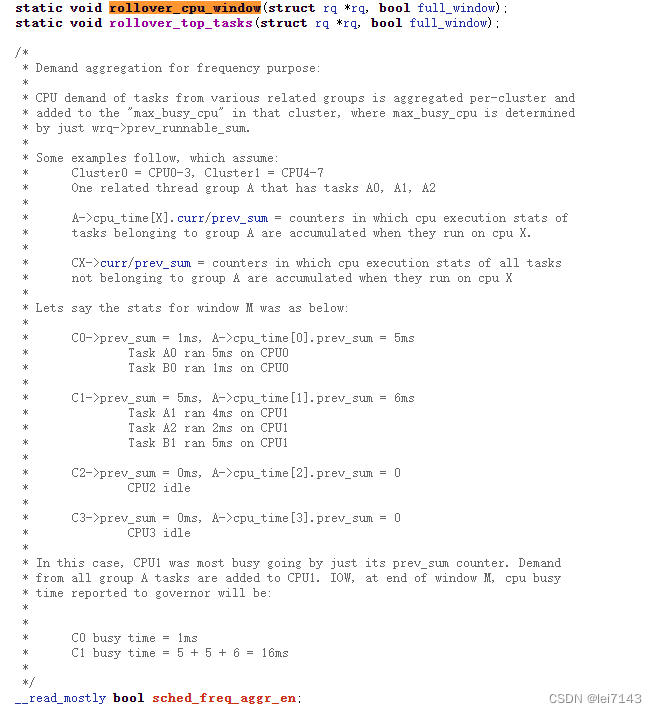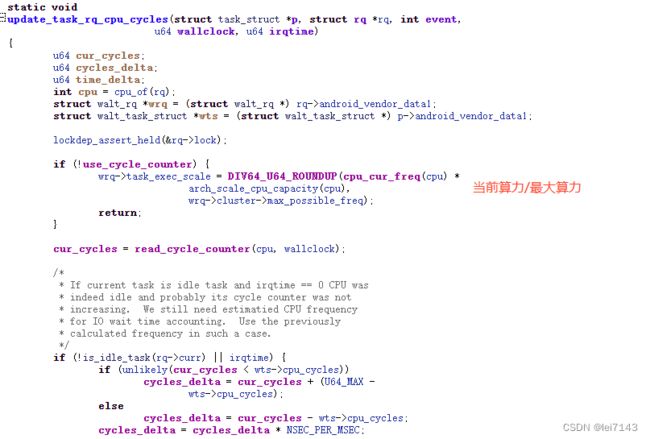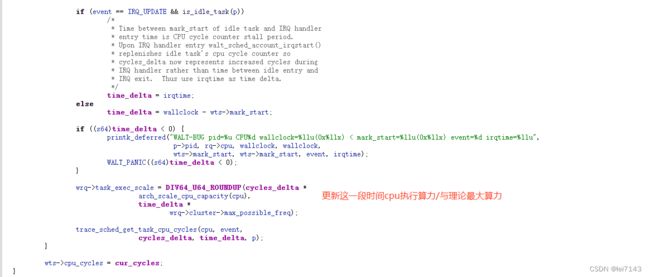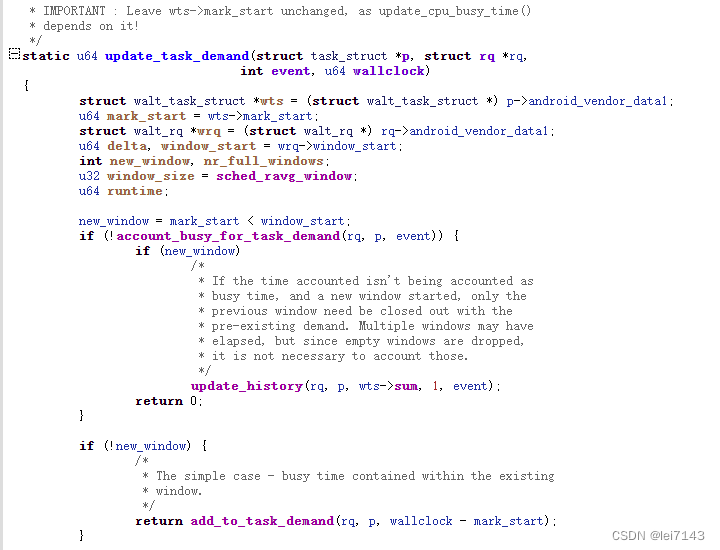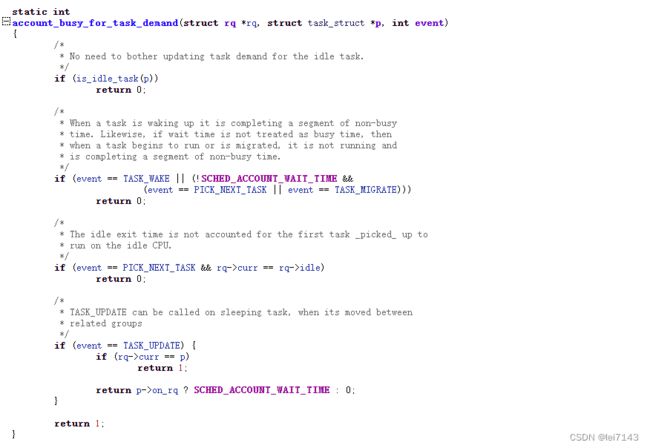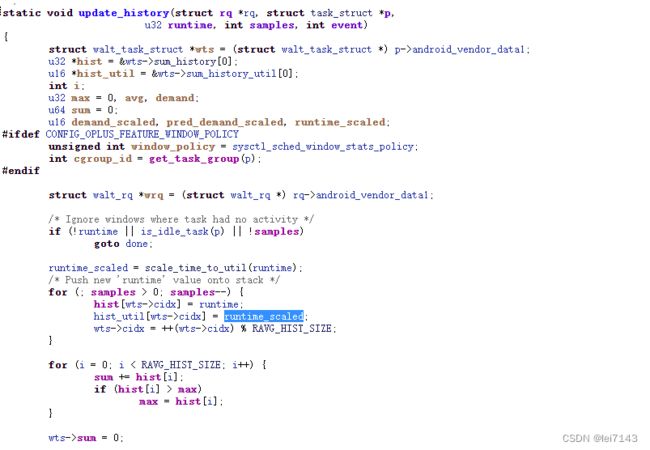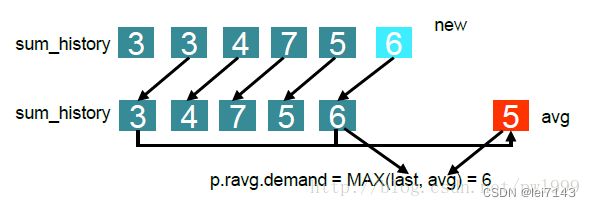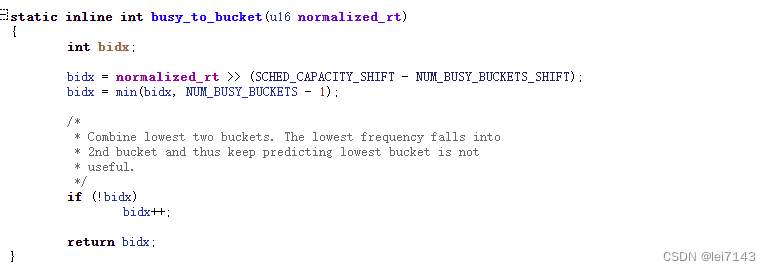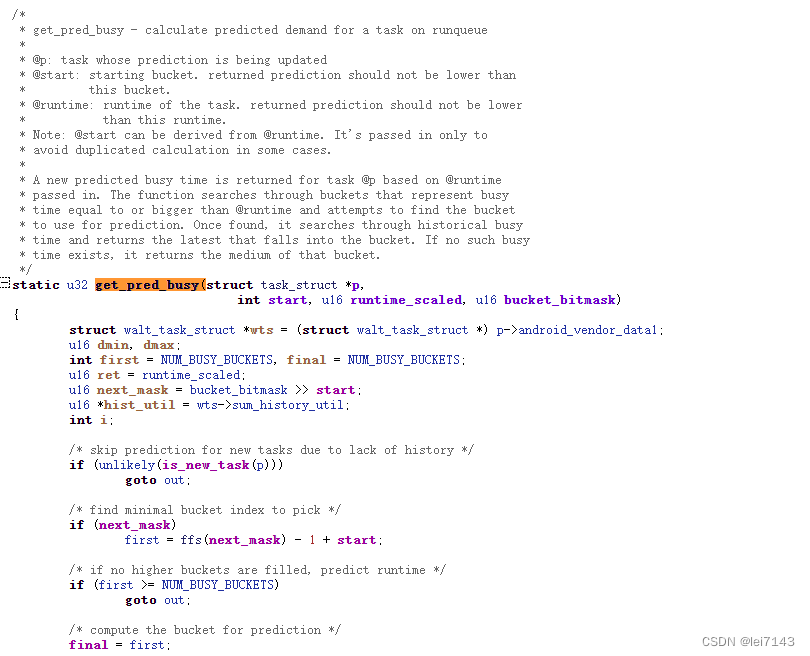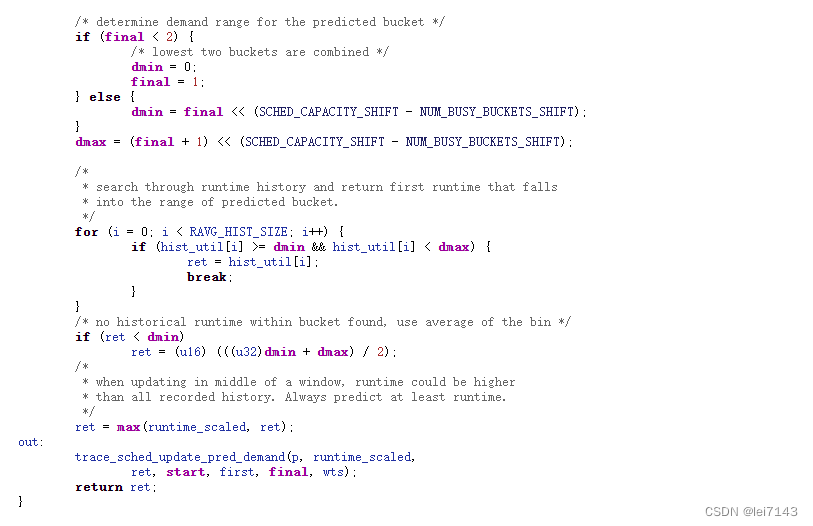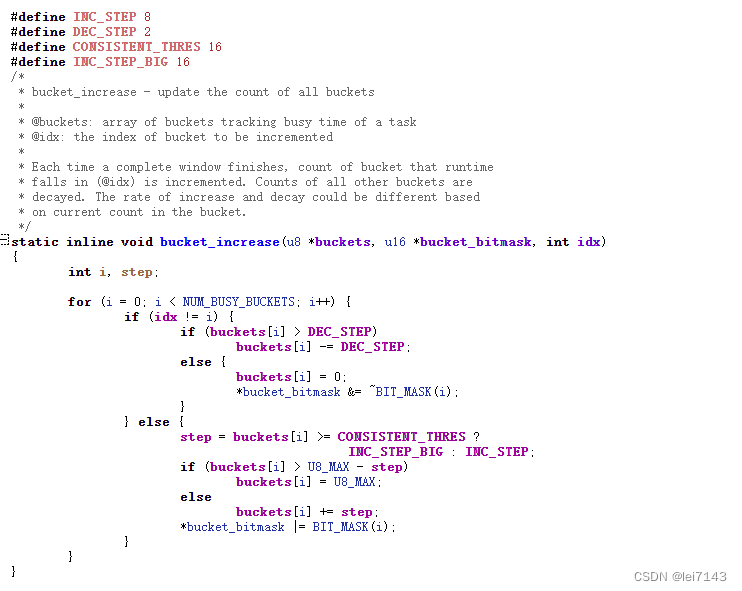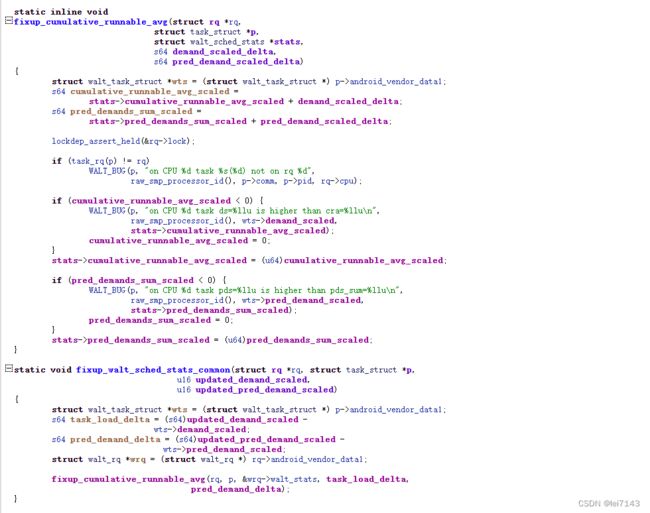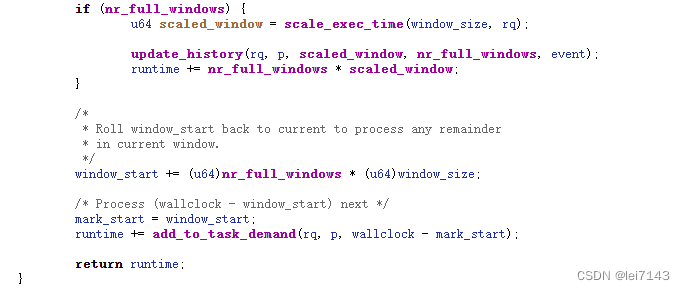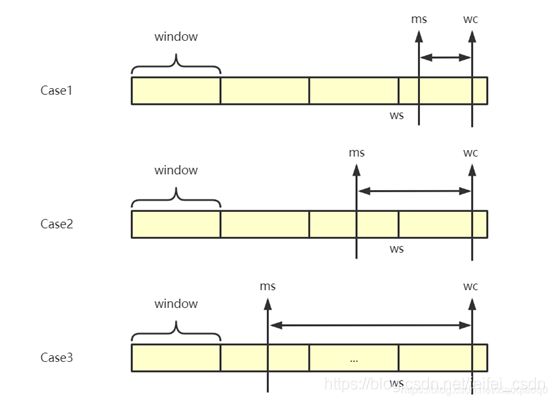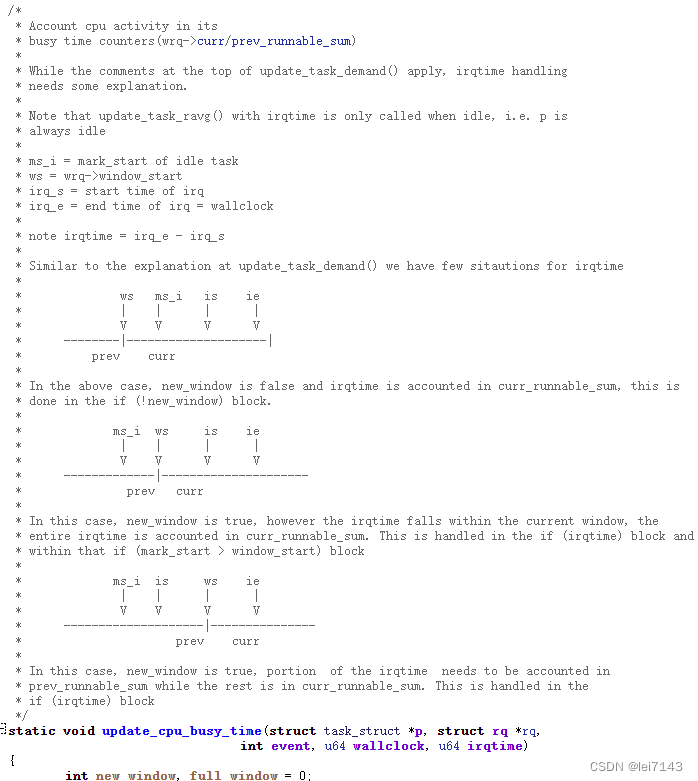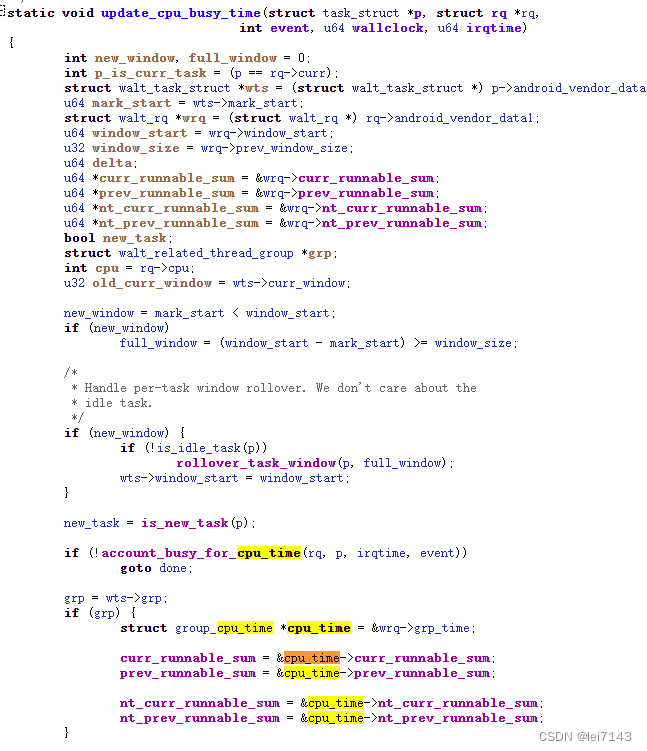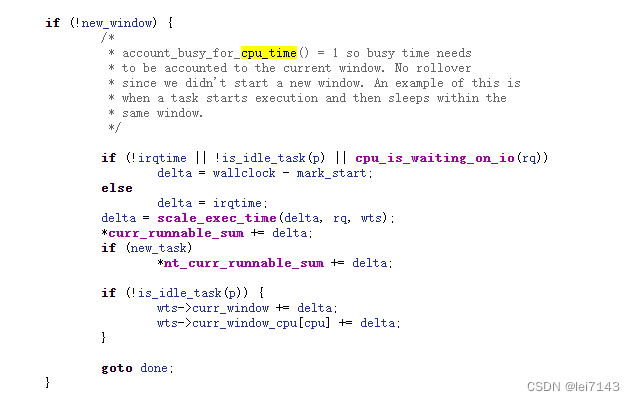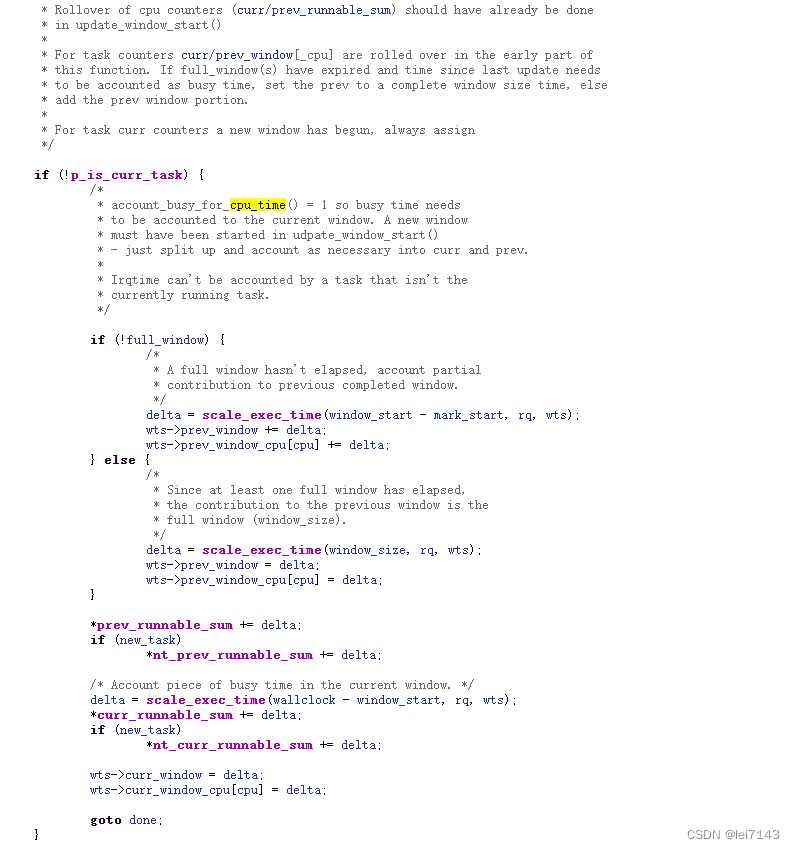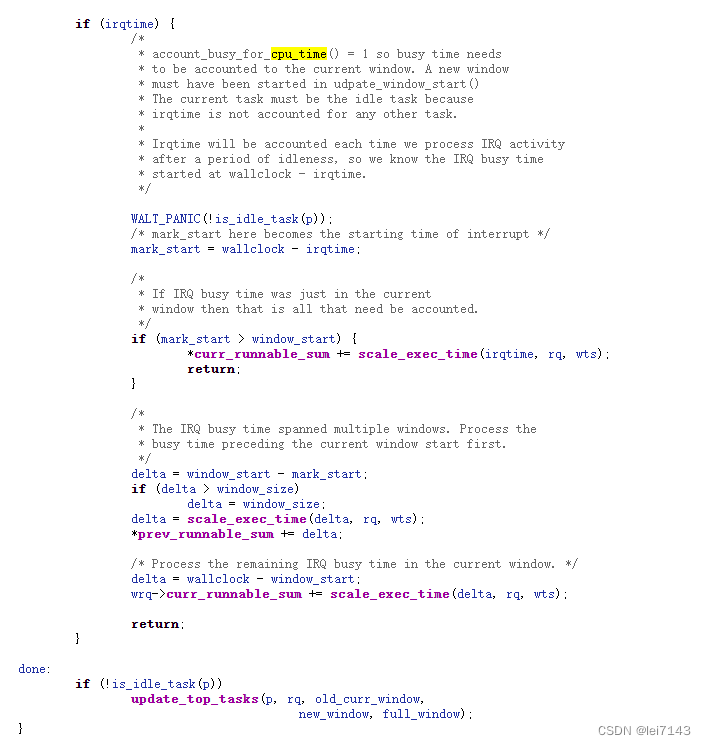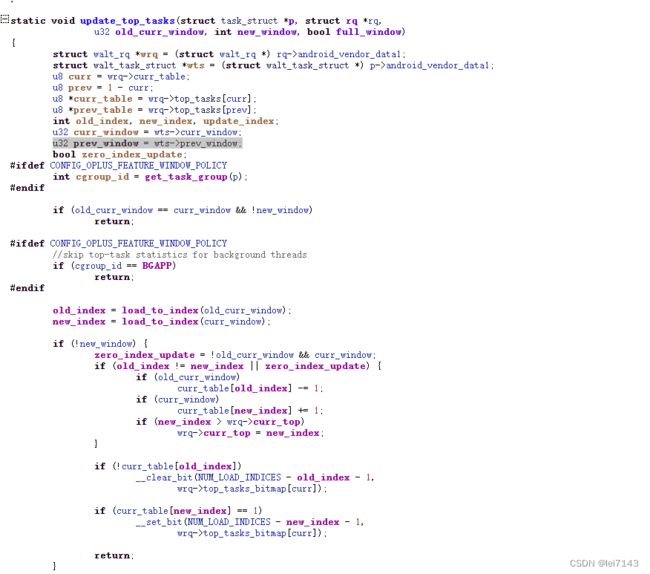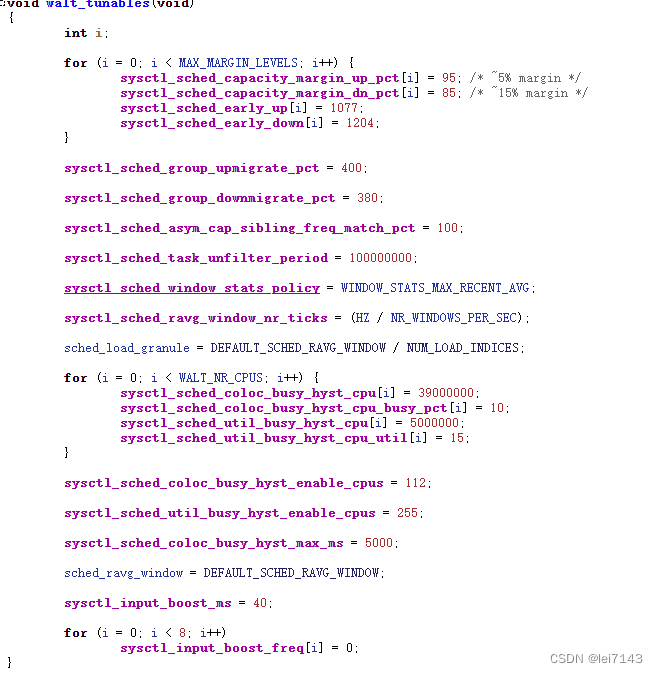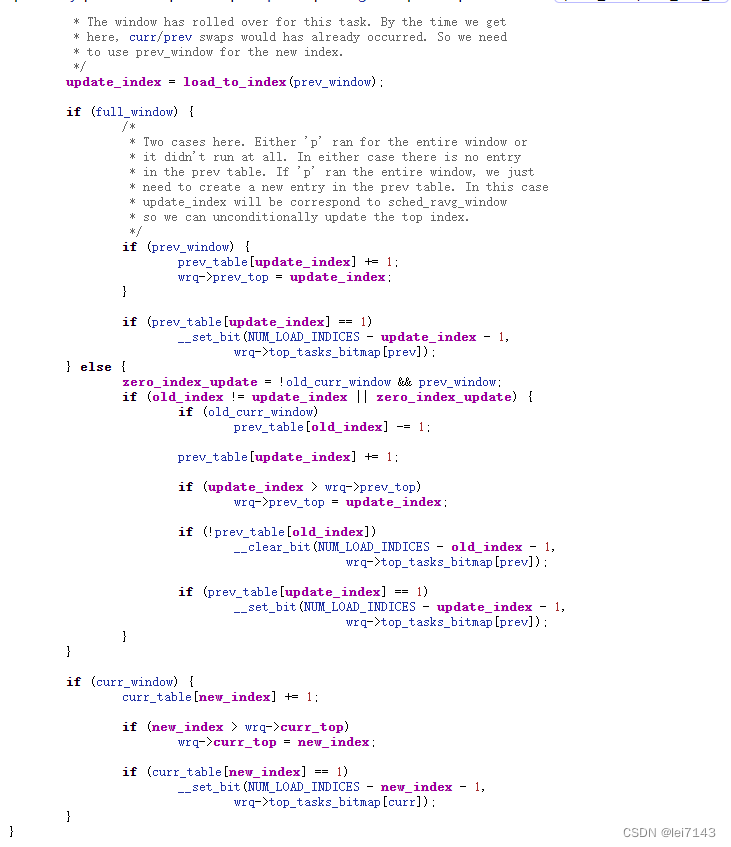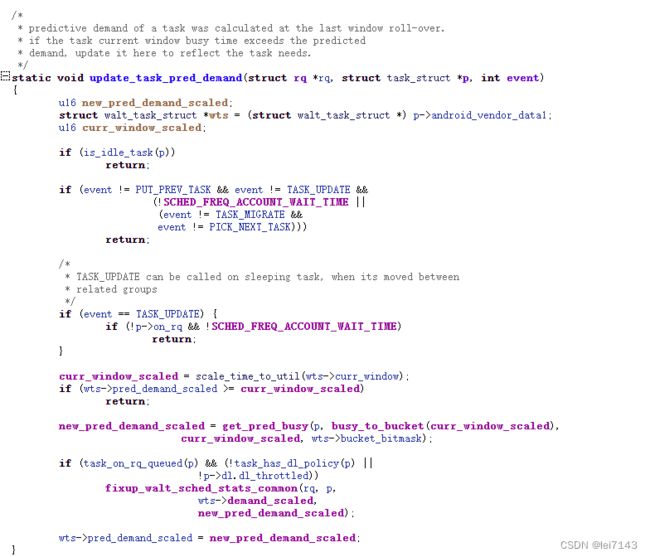walt 调度算法
目录
walt_update_task_ravg
update_window_start
update_task_cpu_cycles
update_task_rq_cpu_cycles
update_task_demand(p, rq, event, wallclock)
update_history(rq, p, wts->sum, 1, event)
update_cpu_busy_time(p, rq, event, wallclock, irqtime)
update_top_tasks
static void update_task_pred_demand
Walt 算法
WALT负载统计原理_walt算法_森森浅浅笙笙的博客-CSDN博客
CPU负载均衡之WALT学习【转】_mb5fdcad0be2e90的技术博客_51CTO博客
1、A task’s demand is the maximum of its contribution to the most recently completed window and its average demand over the past N windows.
WALT “forgets” blocked time entirely:即只统计runable和running time,可以对于Task的实际耗时有更准确的统计,可以通过demand预测;更新demand 通过函数account_busy_for_task_demand判断
walt rq 初始化
linux/sched/walt.h
struct walt_task_struct {
...
}
2、CPU busy time - The sum of execution times of all tasks in the most recently completed window;WALT “forgets” cpu utilization as soon as tasks are taken off of the runqueue;
更新通过account_busy_for_cpu_time函数判断
struct walt_task_struct 、struct walt_rq 内嵌到tast_struct 和 struct rq 里面
walt_update_task_ravg
walt_update_task_ravg 更新demand 和 cpu busy time
kernel-5.10/kernel_platform/msm-kernel/kernel/sched/walt/walt.c
update_window_start
old_window_start = update_window_start(rq, wallclock, event);
根据当前时间wallclock 更新walt_rq 中当前窗口起始时间;
如果wallclock 和 walt_rq->window_start 间隔N(N>=1)个窗口周期,就需要walt_rq->window_start 向前偏移N个窗口周期;prev_window_size 赋值为窗口周期;
rollover_cpu_window()
update_task_cpu_cycles
2243 if (!wts->mark_start) {
2244 update_task_cpu_cycles(p, cpu_of(rq), wallclock);
2245 goto done;
2246 }
任务标记时间还没有开始,则根据cpu 周期更新rq 周期,再赋值给walt_task_struct 周期;
cycles cup周期;更新cycles 时时间last_cc_update (即为wallclock)
update_task_rq_cpu_cycles
更新rq 和 task 运行时钟周期及窗口负载(执行算力*时间/理论最大执行算力*时间)
update_task_demand(p, rq, event, wallclock)
参考
https://www.cnblogs.com/lingjiajun/p/12317090.html![]() https://www.cnblogs.com/lingjiajun/p/12317090.html
https://www.cnblogs.com/lingjiajun/p/12317090.html
这里wrq->window_start 已经根据wallclock 更新了;wts->mark_start 还没有更新
account_busy_for_task_demand 判断是否影响任务demand(负载),当不需要更新时如果这个时候到一个新的窗口,那就需要更新窗口历史数据
这个函数只有这一处地方调用
当负载需要更新, 如果不是新的窗口,执行add_to_task_demand ,等效这段时间中,满算力执行的时间,更新wts->sum
update_history(rq, p, wts->sum, 1, event)
不同的内核版本有些细微差异
struct walt_task_struct {
u32 sum_history[RAVG_HIST_SIZE];
u16 sum_history_util[RAVG_HIST_SIZE];
}
runtime_scale=scale_time_toutil(runtime);
这里将walt 窗口大小 20ms = 20*1000*1000 ns,分为1024 等分;scale_time_toutil 就是计算占用的等份。
sum_history[]记录的时机;
sum_history_util[]记录的等份;
类似上面这个图
walt 算法5 个窗口,这里将
hist[3] => 赋值给hist[4]
hist[2] => 赋值给hist[3]
...
hist[1] => 赋值给hist[2]
再将runtime 赋值给到hist[0]
sum 为 更新后hist数组和,max 为更新后hist数组最大值
再根据配置,获取demand(等效最近5个窗口计算出来的负载)
update_history
参考
https://www.cnblogs.com/lingjiajun/p/12317090.html
pred_demand_scaled 用于EAS ,根据当前窗口sum,得出bucket index,再从sum_history_util 中找到最接近 bucket index << 6 对应的历史sum_util 返回
update_history -> predict_and_update_buckets
SCHE_CAPACITY = 1024
SCHE_CAPACITY_SHIFT = 10
NUM_BUSY_BUCKETS = 16
NUM_BUSY_BUCKETS_SHIFT = 4
busy_to_bucket
就是将 wts->sum 计算为窗口时间等份再 >> 6 ;
这里就相当NUM_BUSY_BUCKETS 有16 个值分别对应窗口时间等份为
[960,1024]=15
[896,960)=14
...
[64,128)=1
[0,64)=0
这里ffs(num)获取num 第一个为1 的bit 位置;ffs(0)=0;ff(1)=1;ff(8)=4
就是找一个比start 大的第一个位置位置
这里dim<<6 dmax<<6 就相当还原了 wts->sum 为窗口时间的份数;找到历史中离当前时间最近的历史负载中在dim 和 dmax 的历史负载
7、update_history->fixup_walt_sched_stats_common
fixup_walt_sched_stats_common(rq, p, demand_scaled, pred_demand_scaled);
直接根据结果更新walt_rq->walt_sched_stats;这里其实是 delta(demand_scaled) 和 delta(pred_demand_scaled) 累加值
337 stats->cumulative_runnable_avg_scaled + demand_scaled_delta;
338 s64 pred_demands_sum_scaled =
339 stats->pred_demands_sum_scaled + pred_demand_scaled_delta;
update_history wts 更新
Sched_Boost小结
调度器分支之RTG_内核工匠的博客-CSDN博客
在后续的kernel版本升级及代码演进中,又进行了一些功能的调整,比如在5.4内核上,引入skip_min来替代perferredcluster,并通过sched_min_task_util_for_colocation来过滤掉负载较低的任务,当任务负载低于sched_min_task_util_for_colocation时,其选核时的优先调度大核任然可以持续维持sched_task_unfilter_period的时间(这个名字也很有趣,不过滤的时间周期,迟滞一段时间)。整体功能并没有发生大的变化。
这里就是完整窗口了及剩下的最后一个窗口
update_cpu_busy_time(p, rq, event, wallclock, irqtime)
【内核调度、负载计算】【WALT】【update_cpu_busy_time】_walt调度_money_yuan的博客-CSDN博客
update_cpu_busy_time 中非新的窗口
高通支持CONFIG_ARM_QCOM_CPUFREQ_HW 使用cpu_cycle_counter;不使用cpu_cycle_counter 那就
wrq->task_exec_scale = DIV64_U64_ROUNDUP(cpu_cur_freq(cpu) *arch_scale_cpu_capacity(cpu), wrq->cluster->max_possible_freq);
如果使用cpu_cycle_counter 那就获取上一次到当前cpu cycle ,计算出delta 时间
cycles_delta = cur_cycles - wts->cpu_cycles;
cycles_delta = cycles_delta * NSEC_PER_MSEC;
time_delta = wallclock - wts->mark_start;
wrq->task_exec_scale = DIV64_U64_ROUNDUP(cycles_delta *arch_scale_cpu_capacity(cpu),
time_delta *wrq->cluster->max_possible_freq);
scale_exec_time
walt demand(boost) 就跟scale_exec_time 很类似; (curr_freq/cpuinfo.max) * (max_cap/1024) 表示当前cpu 频点curr_freq和当前cpu 算力max_cap
task util 跟 scale_time_to_util 很类似
1024/window_size 表示将window_size (20ms)分为1024 份没一份时间;
非当前任务
计算对上一个窗口的贡献
只跨越一个窗口,window_start-mark_start 指在上一个窗口时间;
跨越了多个窗口,那最近上一个窗口时间是窗口打下即window_size;
计算对当前窗口贡献
当前窗口时间为wallclock-window_start
update_top_tasks
调度16ms,NUM_LOAD_INDICES 是 1000
#define DEFAULT_SCHED_RAVG_WINDOW 16000000
sched_load_granule = DEFAULT_SCHED_RAVG_WINDOW / NUM_LOAD_INDICES;
static void update_task_pred_demand
不同算法对比:
cfs eas
task placement task load (pelt) task demand(walt)
balance task load(pelt) task load(pelt)
cupfreq task utility (pelt) task utility(walt)
